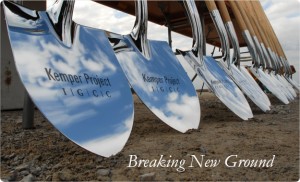|
Listen To The Article
|

Photo Courtesy of Mississippi Power and the Southern Company
Mississippi Power (MP) is moving forward with a massive new project to enhance electricity production in the southern United States. Currently under construction, their new power plant is located on several hundred acres about 30 miles north of Meridian, in Kemper County, and was specifically located to make use of regional fuel sources. Ground was officially broken on March 10, 2011, and a number of state and local officials were on hand to welcome the construction project. The 582-megawatt plant is scheduled to be online in preparation for increased demand by the summer of 2014.
The new plant will use lignite, a local brown coal, as its main power source. Mississippi has an estimated lignite reserve of four billion tons, and Kemper County has an abundance of lignite and natural gas resources. The plant will have its own lignite mines onsite, which will reduce fuel transportation time and any associated costs, resulting in a lower energy production price per kilowatt hour.
Rather than burning coal directly, the plant will convert lignite to gas using an integrated gasification combined cycle (IGCC). After its conversion into gas, the fuel will be burned to create power. This system is more efficient than crushing and burning coal directly.
With an IGCC system, lignite is fed into a gasifier and subjected to intense heat and pressure that forces it to go through a chemical reaction. This reaction turns the coal into a synthetic gas, or “syngas,” with various useful components. The resulting syngas is then used to power gas turbines, producing electricity.
In addition, the new plant adapts the IGCC process by running any unconverted coal back through the system a second time to increase gas output. This converts a higher percentage of the original fuel for electricity generation. The plant will also make use of local natural gas reserves to provide additional power without the gasification step.
Along with the plant’s energy-related benefits, the project will provide more than 1,000 construction jobs and 260 permanent jobs for this rural area. With the still-lingering effects of the economic downturn and the BP oil spill, the new jobs and increased local and state tax revenues will be a windfall for Mississippi’s damaged economy.
In order to construct this plant and meet EPA emissions regulations, Mississippi Power accepted grants and federal assistance totalling $682 million, along with loan guarantees from the federal government. Mississippi Power’s investment totals approximately $2.4 billion for this project.
Coal-Fired Power Generation and the Future
Coal-fueled power plants are being built at a rapid pace worldwide in order to handle increased residential and commercial energy demands. As a natural resource, coal is easier to access than oil and natural gas, and it has a comparatively lower and more stable commodities price. It provides a significant cost savings for electricity consumers when compared to nuclear, natural gas, and oil-fired power plants.
As of 2009, the United States had 594 coal-fired power plants out of 6,274 power generation facilities. Of these, 1,203 were petroleum-based power plants and another 1,652 were powered by natural gas. With the second-largest coal reserves in the world, the United States is ideally suited to ramp up its electricity generation and fuel independence by constructing a substantial number of coal-fired power plants to replace those utilizing petroleum and natural gas.
New technology for IGCC systems allows power plants to use lower grades of coal that were previously considered unsuitable for power generation. This opens up speculation on a wide range of locations and “new” fuel reserves, and will help the U.S. become energy independent if these reserves are properly harnessed for use. Further, if the U.S. stops exporting coal to other countries, our reserves will last longer and provide more power for our own citizens.
The U.S. currently has 21 coal-fired plants in various stages of construction, with another 36 plants announced and seeking the required permissions. Considering the country’s aging power infrastructure, this new construction is a boon to the consumer. More power plants to address demand should reduce brownouts and rolling blackouts, and ensure that each region has ready access to its own power sources.
Coal-fired power plants have a lifespan of between 30 to 40 years, and it’s estimated that the plant will only use a small fraction of local fuel reserves during its operational years. It would be beneficial to establish more IGCC plants in coal-rich regions such as this to make use of local natural resources, and to reduce our dependence on foreign fuel imports earmarked for electricity generation.
____________________________________________________________
Slash your lighting bill by 90%
And Don’t Change Another Light Bulb for 40 Years!
____________________________________________________________